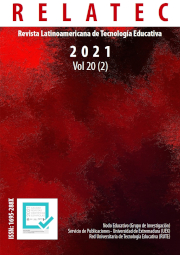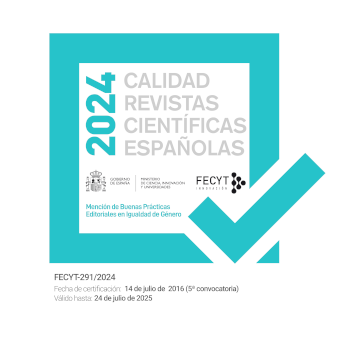Interacción social de universitarios colombianos y españoles en medios sociales y perfiles predominantes
DOI:
https://doi.org/10.17398/1695-288X.20.2.9Palabras clave:
Medios sociales, Redes sociales, Comunicación social, Interacción social, Estudiantes universitarios, Perfil de usuarioResumen
Los universitarios interactúan y se comunican utilizando los medios sociales (MMSS) y desarrollan actividades online que definen sus perfiles como usuarios. Esta investigación indaga sobre los usos de los MMSS que hacen estudiantes colombianos y españoles (N=501) para interaccionar socialmente, al tiempo que identifica sus perfiles asociados a las actividades que realizan. Se adopta una metodología cuantitativa de carácter descriptivo, con un posterior análisis de varianza constatando la existencia de diferencias estadísticamente significativas en función de las variables género, edad y nacionalidad. Los resultados evidencian que las universitarias sobresalen por encima de sus compañeros al tener una mayor presencia, actividad social e implicación en los MMSS, realizar frecuentemente tareas de actualización de su estado, publicación de mensajes, comentarios, vídeos o fotografías, enviar mensajes, visitar y valorar cuentas ajenas. Esto contribuye a esbozar perfiles como creadoras y críticas, y por el contrario, sus compañeros adoptan perfiles coleccionistas y espectadores. Se observan perfiles heterogéneos asociados a la edad relacionados con los intereses de los universitarios. Por nacionalidad se constatan diferencias en el uso generalizado de determinados MMSS y en los perfiles de los usuarios. Los españoles destacan por ser creadores y espectadores, y los colombianos priman perfiles creadores y críticos. Los MMSS establecen fórmulas de expresión propias, por ello los universitarios deberían elegir aquellos que más se ajustan a sus objetivos.
Descargas
Referencias
Athwal, N., Istanbulluoglu, D., & McCormack, S.E. (2019). The allure of luxury brands’ social media activities: a uses and gratifications perspective. Information Technology & People, 32(3), 603-626. https://doi.org/10.1108/ITP-01-2018-0017
Bachmann, P. (2019). Public relations in liquid modernity: How big data and automation cause moral blindness. Public Relations Inquiry, 8(3), 319-331. https://doi.org/10.1177/2046147X19863833
Becerra, J.R., López, F., & Jasso, J.L. (2021). Uso problemático de las redes sociales y teléfono móvil: impulsividad y horas de uso. Revista de Psicología de la Universidad Autónoma del Estado de México, 10(19), 28-46. https://revistapsicologia.uaemex.mx/article/view/16105
Berea, G. A., González, J., & Sampedro-Requena, B.E. (2019). El efecto de las TIC y redes sociales en estudiantes universitarios. RIED. Revista Iberoamericana de Educación a Distancia, 22(2), 153-176. https://doi.org/10.5944/ried.22.2.23178
Bordone, A. (2020). The ephemerality of the snapchat image. Resisting Matter: Describing Archival Objects. AIS-Architecture Image Studies, 1(1), 64-70. https://doi.org/10.48619/ais.v1i1.301
Botas, D., Garrido, P., & García, J.G. (2021). Universitarios y redes sociales. Estudio sobre la percepción de la privacidad y su gestión. Comunicación y Hombre, 17, 139-151. https://doi.org/10.32466/eufv-cyh.2021.17.624.139-151
Chang, Y.S., Chen, S.Y., Yu, K.C., Chu, Y.H., & Chien, Y.H. (2017). Effects of cloud-based m-learning on student creative performance in engineering design. British Journal of Educational Technology, 48(1), 101-112. https://doi.org/10.1111/bjet.12343
Choi, T.R., & Sung, Y. (2018). Instagram versus Snapchat: Self-expression and privacy concern on social media. Telematics and Informatics, 35(8), 2289-2298. https://doi.org/10.1016/j.tele.2018.09.009
Chu, T.H., & Yeo, T.E. (2020). Rethinking mediated political engagement: social media ambivalence and disconnective practices of politically active youths in Hong Kong. Chinese Journal of Communication, 13(2), 148-164. https://doi.org/10.1080/17544750.2019.1634606
Del Moral, M. E., Bellver, M. C., & Guzmán, A. P. (2020). Dimensiones del Ecosistema Digital Universitario: Validación del Instrumento «University Digital Ecosystem»(UN-DIGECO). Revista Latinoamericana de Tecnología Educativa-RELATEC, 19(1), 9-27. http://dx.doi.org/10.17398/1695-288X.19.1.9
Dommett, E.J. (2019). Understanding student use of twitter and online forums in higher education. Education and Information Technologies, 24(1), 325-343. https://doi.org/10.1007/s10639-018-9776-5
Dubovi, I., & Tabak, I. (2020). An empirical analysis of knowledge co-construction in YouTube comments. Computers & Education, 156, 1-9. https://doi.org/10.1016/j.compedu.2020.103939
Espuny, C., González, J., Lluixà, M., y Gisbert, M. (2011). Actitudes y expectativas del uso educativo de las redes sociales en los alumnos universitarios. RUSC. Universities and Knowledge Society Journal, 8(1), 171- 185. http://dx.doi.org/10.7238/rusc.v8i1.839
Fondevila, F.J., Marqués, J., Mir-Bernal P., & Polo-López, M. (2019). Uses of WhatsApp in the Spanish University Student. Pros and cons. Revista Latina de Comunicación Social, 74, 308-324. http://www.revistalatinacs.org/074paper/1332/15en.html
González-Ramírez, T., & López-Gracia, Á. (2018). La identidad digital de los adolescentes: usos y riesgos de las Tecnologías de la Información y la Comunicación. Revista Latinoamericana de Tecnología Educativa RELATEC, 17(2), 73-85. https://doi.org/10.17398/1695-288X.17.2.73
Gündüz, U. (2017). The effect of social media on identity construction. Mediterranean Journal of Social Sciences, 8(5), 85-85. http://www.richtmann.org/journal/index.php/mjss/article/view/10062
Han, Y., Lappas, T., & Sabnis, G. (2020). The Importance of Interactions Between Content Characteristics and Creator Characteristics for Studying Virality in Social Media. Information Systems Research, 31(2), 576-588. https://doi.org/10.1287/isre.2019.0903
Hair, J.F., Black, W.C., Babin, B.J., Anderson, R.E., & Tatham, R.L. (2010). Multivariate data analysis (Vol. 7). Prentice Hall.
Hei, E.T., Hang, C., & Chiu, D.K. (2019). Analyzing the use of Facebook among university libraries in Hong Kong. The Journal of Academic Librarianship, 45(3), 175-183. https://doi.org/10.1016/j.acalib.2019.02.007
Igartua, J.J., & Rodríguez-de-Dios, I. (2016). Correlatos motivacionales del uso y la satisfacción con Facebook en jóvenes españoles. Cuadernos.info, 38, 107-119. http://dx.doi.org/10.7764/cdi.38.848
Ito, M., Baumer, S., Bittanti, M., Cody, R., Stephenson, B.H., Horst, H.A., …& Perkel, D. (2019). Hanging out, messing around, and geeking out: Kids living and learning with new media. MIT Press.
Jackman, W.M. (2019). YouTube usage in the university classroom: an argument for its pedagogical benefits. International Journal of Emerging Technologies in Learning (IJET), 14(9), 157-166. https://doi.org/10.3991/ijet.v14i09.10475
Janakiraman, S., Watson, S.L., Watson, W.R., & Newby, T. (2021). Effectiveness of digital games in producing environmentally friendly attitudes and behaviors: A mixed methods study. Computers & Education, 160, 104043. https://doi.org/10.1016/j.compedu.2020.104043
Jiménez-Sánchez, A., & Vayas, E.C. (2021). Motivational dimensions on Facebook in university students and workers from Ecuador. Revista de Comunicación de la SEECI, (54), 43-63. https://doi.org/10.15198/seeci.2021.54.e656
Jing, A., Xiang, C., Kim, S., Billinghurst, M., & Quigley, A. (2019). SnapChat: an Augmented Reality Analytics Toolkit to Enhance Interactivity in a Collaborative Environment. In 17th International Conference on Virtual-Reality Continuum and its Applications in Industry, (pp. 1-2). ACM. https://doi.org/10.1145/3359997.3365725
Khan, M.L. (2017). Social media engagement: What motivates user participation and consumption on YouTube? Computers in Human Behavior, 66, 236-247. https://doi.org/10.1016/j.chb.2016.09.024
Korhonen, A.M., Ruhalahti, S., & Veermans, M. (2019). The online learning process and scaffolding in student teachers’ personal learning environments. Education and Information Technologies, 24(1), 755-779. https://doi.org/10.1007/s10639-018-9793-4
Kumar, V., & Nanda, P. (2019). Social media in higher education: A framework for continuous engagement. International Journal of Information and Communication Technology Education, 15(1), 97-108. https://doi.org/10.4018/IJICTE.2019010107
Li, C. & Bernoff, J. (2011). Groundswell: Winning in a world transformed by social technologies. Harvard Business Press.
Lizaso, I., Sánchez-Queija, M.I., Parra, Á., & Arranz, E. (2018). La participación social online y offline de estudiantes
universitarios españoles. OBETS. Revista de Ciencias Sociales, 13(2), 547-567. https://doi.org/10.14198/OBETS2018.13.2.04
Maldonado, G.A., García, J. & Sampedro-Requena, B.E. (2019). El efecto de las TIC y redes sociales en estudiantes universitarios. RIED. Revista Iberoamericana de Educación a Distancia, 22(2), 153-176. https://doi.org/10.5944/ried.22.2.23178
Manca, S. (2020). Bridging cultural studies and learning science: An investigation of social media use for Holocaust memory and education in the digital age. Review of Education, Pedagogy, and Cultural Studies, 1-32. https://doi.org/10.1080/10714413.2020.1862582
Marcelino, G.V. (2015). Migración de los jóvenes españoles en redes sociales, de Tuenti a Facebook y de Facebook a Instagram. La segunda migración. ICONO14, 13(2), 48-72. https://doi.org/10.7195/ri14.v13i2.821
Marín-Díaz, V., Vega-Gea, E., & Passey, D. (2019). Determinación del uso problemático de las redes sociales por estudiantes universitarios. RIED. Revista Iberoamericana de Educación a Distancia, 22(2), 135-152. https://doi.org/10.5944/ried.22.2.23289
Martínez-Sala, A.M., Segarra-Saavedra, J., & Monserrat-Gauchi, J. (2018). Los millennials como prosumers y adprosumers en las redes sociales corporativas. Cuadernos.info, 43, 137-159. https://doi.org/10.7764/cdi.43.1335
Mason, A.J., & Carr, C.T. (2021). Toward a Theoretical Framework of Relational Maintenance in Computer-Mediated Communication. Communication Theory, qtaa035. https://doi.org/10.1093/ct/qtaa035
Molinillo, S., Anaya-Sánchez, R., Morrison, A.M., & Coca-Stefaniak, J.A. (2019). Smart city communication via social media: Analysing residents' and visitors' engagement. Cities, 94, 247-255. https://doi.org/10.1016/j.cities.2019.06.003
Nandagiri, V., & Philip, L. (2018). Impact of influencers from Instagram and YouTube on their followers. International Journal of Multidisciplinary Research and Modern Education, 4(1), 61-65.
Neverkovich, S.D., Bubnova, I.S., Kosarenko, N.N., Sakhieva, R.G., Sizova, Z.M., Zakharova, V.L., & Sergeeva, M.G. (2018). Students’ internet addiction: study and prevention. Eurasia Journal of Mathematics, Science and Technology Education, 14(4), 1483-1495. https://doi.org/10.29333/ejmste/83723
Ooi, K.B., Lee, V.H., Tan, G.W., Hew, T.S., & Hew, J.J. (2018). Cloud computing in manufacturing: The next industrial revolution in Malaysia? Expert Systems with Applications, 93, 376-394. https://doi.org/10.1016/j.eswa.2017.10.009
Otzen, T., & Manterola, C. (2017). Técnicas de Muestreo sobre una Población a Estudio. International journal of morphology, 35(1), 227-232. http://dx.doi.org/10.4067/S0717-95022017000100037
Padilla, E.J., Portilla, G.I., & Torres, M. (2020). Aprendizaje autónomo y plataformas digitales: el uso de tutoriales de YouTube de jóvenes en Ecuador. Estudios pedagógicos (Valdivia), 46(2), 285-297.http://dx.doi.org/10.4067/S0718-07052020000200285
Parady, G., Katayama, G., Yamazaki, H., Yamanami, T., Takami, K., & Harata, N. (2019). Analysis of social networks, social interactions, and out-of-home leisure activity generation: Evidence from Japan. Transportation, 46, 537–562. https://doi.org/10.1007/s11116-018-9873-8
Pousti, H., Urquhart, C., & Linger, H. (2021). Researching the virtual: A framework for reflexivity in qualitative social media research. Information Systems Journal, 31(3), 356-383. https://doi.org/10.1111/isj.12314
Scott, G.G., Boyle, E.A., Czerniawska, K., & Courtney, A. (2018). Posting photos on Facebook: the impact of narcissism, social anxiety, loneliness, and shyness. Personality and Individual Differences, 133, 67-72. https://doi.org/10.1016/j.paid.2016.12.039
Shahbaznezhad, H., Dolan, R., & Rashidirad, M. (2021). The role of social media content format and platform in Users' engagement behavior. Journal of Interactive Marketing, 53, 47-65. https://doi.org/10.1016/j.intmar.2020.05.001
Shane-Simpson, C., Manago, A., Gaggi, N., & Gillespie-Lynch, K. (2018). Why do college students prefer Facebook, Twitter, or Instagram? Site affordances, tensions between privacy and self-expression, and implications for social capital. Computers in Human Behavior, 86, 276-288. https://doi.org/10.1016/j.chb.2018.04.041
Sun, H. (2019). Case Study-Spotify. In: Digital Revolution Tamed, (pp 135-170). Palgrave Macmillan. https://doi.org/10.1007/978-3-319-93022-0_5
Tarullo, R. (2020). ¿Por qué los y las jóvenes están en las redes sociales? Un análisis de sus motivaciones a partir de la teoría de usos y gratificaciones. Revista Prisma Social, 29, 222–239. https://revistaprismasocial.es/issue/view/194
Terzi, B., Bulut, S., & Kaya, N. (2019). Factors affecting nursing and midwifery students’ attitudes toward social media. Nurse Education in Practice, 35, 141-149. https://doi.org/10.1016/j.nepr.2019.02.012
Thelwall, M., & Vis, F. (2017). Gender and image sharing on Facebook, Twitter, Instagram, SnapChat and WhatsApp in the UK. Aslib Journal of Information Management, 69(6), 702-720. https://doi.org/10.1108/AJIM-04-2017-0098
Trillos, J.J., & Ballesteros, H. (2020). ¿Leer en texto impreso o en Smartphone? Oportunidades y amenazas para Educar del pensamiento crítico. Revista Cedotic, 5(2), 72-97. https://doi.org/10.15648/cedotic.2.2020.2746
Troncoso, G., Katayama, G., Yamazaki, H., Yamanami, T., Takami, K., & Harata, N. (2019). Analysis of social networks, social interactions, and out-of-home leisure activity generation: Evidence from Japan. Transportation, 46(3), 537-562. https://doi.org/10.1007/s11116-018-9873-8
Valkenburg, P.M., Koutamanis, M., & Vossen, H.G. (2017). The concurrent and longitudinal relationships between adolescents' use of social network sites and their social self-esteem. Computers in Human Behavior, 76, 35-41. https://doi.org/10.1016/j.chb.2017.07.008
Vrain, E., & Wilson, C. (2021). Social networks and communication behaviour underlying smart home adoption in the UK. Environmental Innovation and Societal Transitions, 38, 82-97. https://doi.org/10.1016/j.eist.2020.11.003
Wang, D., Szymanski, B.K., Abdelzaher, T., Ji, H., & Kaplan, L. (2019). The age of social sensing. Computer, 52(1), 36-45. https://doi.org/10.1109/MC.2018.2890173
Yang, J., Fardouly, J., Wang, Y., & Shi, W. (2020). Selfie-viewing and facial dissatisfaction among emerging adults: A moderated mediation model of appearance comparisons and self-objectification. International Journal of Environmental Research and Public Health, 17(2), 1-16. https://doi.org/10.3390/ijerph17020672
Zheng, W., Yuan, C. H., Chang, W. H., & Wu, Y. C. J. (2016). Profile pictures on social media: Gender and regional differences. Computers in Human Behavior, 63, 891-898. https://doi.org/10.1016/j.chb.2016.06.041
Descargas
Publicado
Número
Sección
Licencia
Los autores/as que publiquen en esta revista aceptan las siguientes condiciones:
1. Los autores/as conservan los derechos de autor y ceden a la revista el derecho de la primera publicación, con el trabajo registrado con la licencia Creative Commons Reconocimiento-NoComercial-SinObraDerivada 4.0 International (CC BY-NC-ND), que permite a terceros utilizar lo publicado siempre que mencionen la autoría del trabajo y a la primera publicación en esta revista.
2. Los autores/as pueden realizar otros acuerdos contractuales independientes y adicionales para la distribución no exclusiva de la versión del artículo publicado en esta revista (p. ej., incluirlo en un repositorio institucional o publicarlo en un libro) siempre que indiquen claramente que el trabajo se publicó por primera vez en esta revista.
3. Se permite y recomienda a los autores/as a publicar su trabajo en Internet (por ejemplo en páginas institucionales o personales) antes y durante el proceso de revisión y publicación, ya que puede conducir a intercambios productivos y a una mayor y más rápida difusión del trabajo publicado (vea The Effect of Open Access).









